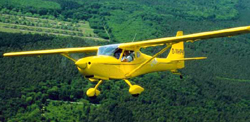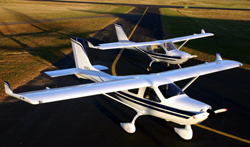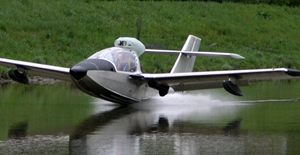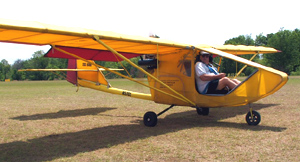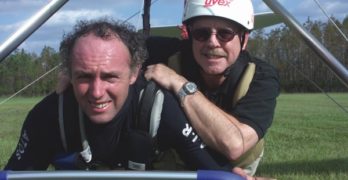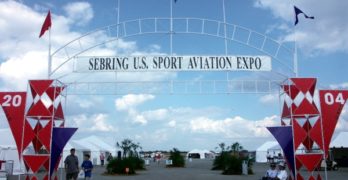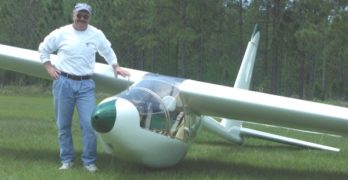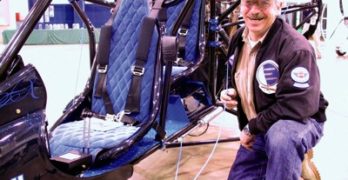FK Lightplanes FK9 Mk IV becomes our 21st SLSA since April 15 (a rate of 3 per month!). A longtime ultralight enthusiast with a list of FAA ratings, importer Tony Anderson has moved fast since securing distribution of Germany’s FK Lightplanes. Since my SPLOG two days ago, Tony was able to confirm by copy of his Airworthiness Certificate the SLSA approval for the FK9 Mk IV on November 17th. Here is a proven microlight design built very lightly (590 pounds empty) using fiberglass over steel construction. Powered by a Rotax 912 or 912S, FK9 cruises at 105 knots and climbs 1,500 fpm at gross (with 100 hp engine at 1,146 pounds gross weight). In service for many years in Germany, FK9 is quite popular with flight schools. It also has the slickest of wing folding mechanisms. A single person can unhook the wing — from the tip — and fold the wing.
Search Results for : Flight Design
Not finding exactly what you expected? Try our advanced search option.
Select a manufacturer to go straight to all our content about that manufacturer.
Select an aircraft model to go straight to all our content about that model.
Jabiru Hits a Double with Twin Approvals
And then we had 20…SLSA approvals, that is. Jabiru’s Pete Krotje announced his company had received not one but two FAA airworthiness certificates for J250 and the new J170. The latter is aimed at the flight training market. Smaller than the J250 which has an enormous baggage area — being based on the the four-seat J400 — the J170 is based on the proven two-seat Jabiru, the Calypso. It will be powered with the company’s four cylinder, 80-hp 2200 engine. Smaller, yes, but J170 still has a broad 45-inch cabin with plenty of headroom. The J170 is big in other ways, too, with a 562 pound useful load and a whopping 35 gallons of fuel (which may not all be used in training applications). Meanwhile J250 is your cross country cruiser with room for all your gear and able to cruise easily at SP/LSA’s 120-knot speed limit.
Interested In Amphibs? If Yes, Plan to Write FAA!
Many of you are aware of FAA’s confused state over “repositionable gear” for LSA floatplanes. At present the agency is stalled regarding the issue. I understand from highly placed officials that a solution could be to allow one gear movement per flight. That would fix the problem but changes move very slowly in the federal bureaucracy. To kick start action, one active producer of floats and flying boats — Czech Aircraft Works, and their U.S. partner, Sport Aircraft Works — has swiftly gotten the agency to release a “Petition for Exemption.” The usual dense federal language describes the petition, but Sport Aircraft Works has made responding much easier. Go to their website and follow the directions; they provide a link to the FAA submission site. Comments must be received by March 6, 2006, so if this matters to you (and it should!), then please take action quickly.
Number One CGS Hawk Retires to Florida Air Museum
Back when the term “ultralight” was new…back in spring of 1982 before FAA issued their now-classic Part 103 regulation…and during the time when ultralights still had to prove themselves by being foot launchable…that’s when bold designer Chuck Slusarczyk introduced the first CGS Hawk at the then-new Sun ‘n Fun Fly-in. It was fully enclosed (you couldn’t foot launch it and all other ultralight were open cockpit airplanes). It had conventional three axis controls (unusual then). But this “outlaw” design proved to be a hit. Over the years, CGS and Chuck have sold over 1,500 Hawks! Now, fittingly, a Hawk has been inducted into the Florida Air Museum. Even more fittingly, this followed one last flight from the airstrip at Sun ‘n Fun’s Paradise City ultralight display area. At the end of the flight, Chuck taxied back one last time. It was a bit emotional to retire Hawk #1, he says.
State of the Art in Hang Gliding
In the last 10 years there have been significant developments in hang glider wings. That may come as a surprise to KITPLANES® readers. After all, the wings don’t look much different from one another, so the changes must be subtle, right?
Well, yes and no. In fact, many subtle changes have occurred as these wings have steadily progressed from a glide angle of 4:1 in the 1970s to the 15:1 glides that are common today. Even as they gained efficiency, the wings haven’t changed a lot in appearance.
But not all of the changes are so subtle. The ATOS VX I flew in late 2004 illustrates a radically different approach to wing design. The ATOS VX can achieve a glide angle of 20:1 and a sink rate of only 118 fpm. The latter number makes this wing competitive with many sailplanes, even though the pilot hangs in the airstream.
An Innovative Design
The design is produced by Aeronautic Innovation Rühle (AIR) and is the creation of Felix Rühle, who worked with composite materials for many years in his role with the German government’s Center for Research and Development in Aerospace Technology in Stuttgart.
An LSA Standards Progress Report
An LSA Standards Progress Report
Before the U.S. Sport Aviation Expo launched its inaugural event on October 28, 2004, members of the ASTM F37 committee writing the industry consensus standards for Light-Sport Aircraft held their fall meeting at a hotel owned by the Sebring International Raceway.
Approximately 60 industry representatives and FAA officials met over a two-and-a-half day schedule to finish work on standards for design and performance, quality assurance, production and continuing airworthiness. Under the catchall title of the Cross Cutting Committee, attendees also worked on standards for engines, props, emergency parachutes, airparks and noise.
Specifications are finished for airplanes, powered parachutes, weight-shift (trikes), lighter than air and several of the cross cutting groups. Standards are well underway for gyroplanes and gliders. All ASTM standards are living documents that must be reviewed every two years and can be changed as needed to improve their functionality. They stand in lieu of FAA certification standards, though numerous FAA personnel have been an integral to their development.
Sebring 2004: First Impressions
The U.S. Sport Aviation Expo in October 2004 was the first event to focus exclusively on Light-Sport Aircraft.
ou never get a second chance to make a first impression. With that in mind, you might ask how visitors regarded the first U.S. Sport Aviation Expo, held in Sebring, Florida, from October 28-31, 2004. The Expo was the first of its kind aiming at the new Sport Pilot/Light-Sport Aircraft (LSA) segment, and it was a focused event, featuring only LSAs and ultralights. Is that two strikes against it or two good reasons for it to succeed?
From what I could see, those who attended the Sebring event were satisfied. Set aside for the moment reports elsewhere that the show was sparsely attended. It was the first of its kind. And as word of mouth is accepted to be the best marketing tool for shows, the attendance figures should present no surprise. The vendors were satisfied, and visitors also seemed to feel good about the selection of aircraft, the availability and ease of demo flights and the wide array of educational forums.
Ultralight Flyer Goes the Distance
There’s only one Carbon Dragon currently flying; it belongs to Steve Arndt, who calls his beautiful version of this ultralight sailplane the Magic Dragon. What he can do with it is indeed quite magical.
On a day when experienced hang glider pilots were only getting in short, half-hour soaring flights at Florida’s well-known Wallaby Ranch Flight Park, Arndt appeared to be gearing up for an entire afternoon of soaring.
“Oh, he’ll be up 3 hours, and we won’t see him until he decides to come back for dinner,” said Wallaby Ranch proprietor Malcolm Jones. Such is the nature of flying the unusually lightweight Carbon Dragon. Most soaring pilots would agree that Arndt’s sailplane and his flying are both remarkable.
An Ultralight Glider
Designed by a team led by the late Jim Maupin and Irv Culver, the Carbon Dragon has a 44-foot wingspan with full-span flaperons, an empty weight of 145 pounds and a gross weight of 335 pounds.
Hand Control PPC
One innovative designer offers an alternative to foot-controlled powered parachute flight.
For those of you that don’t know, most powered parachutes are steered around the sky using your legs. Pushing with your right leg exerts downward force on a steering line routed to the right trailing edge of the canopy/wing, producing drag on that side and initiating a turn in that direction.
The motion isn’t hard-though some designers have added mechanical advantage to make it easier-and the turn is more responsive that you might imagine. But what if you don’t have good use of your legs? How might you fly a powered parachute?
Canadian powered parachute manufacturer Para-Ski offers a handlebar arrangement, and other companies have experimented with similar ideas. But nearly every other supplier of these flying machines uses a foot-steering arrangement of one kind or another. James Leon of Kankakee, Illinois, has another alternative.
Call It Power Steering
While Para-Ski has its handlebars, a measure of physical effort is still involved.
Fk-9 Mark III
Sleek composite microlight performs like a GA aircraft In the Dec. 11 Flyer, I wrote about the Albatros, which I call a hybrid ultralight because it bridges older tube-and-rag ultralights and new all-composite models.
This month we look at the German-built FK-9 from B&F Technik. A new breed with an interesting history, it too emerged from an earlier design. In fact, the FK-9 shown in photos that accompany this story is the glass-fiber Mark 3. Its predecessors, the Mark 1 and Mark 2, used fabric skins, putting them more in the hybrid category.
To review briefly, hybrid microlights are flying machines that employ the best ideas of familiar ultralight designs, such as sewn Dacron wings and aluminum airframes, yet combine those proven components with composite fuselages and welded steel parts. Simple construction keeps many small builders in business.
Conversely, the composite microlights are typically all-composite designs (or composite over steel) using newer construction technology and techniques.
- « Previous Page
- 1
- …
- 120
- 121
- 122
- 123
- 124
- …
- 147
- Next Page »


